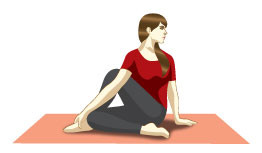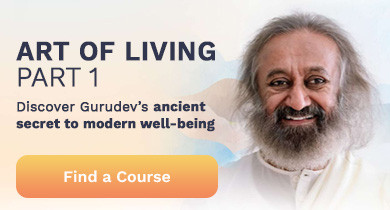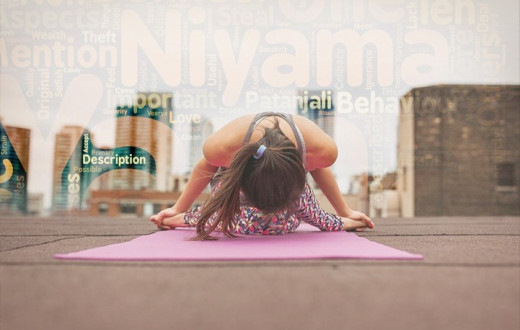By Elizabeth Herman | Updated : October 19, 2020
Conquer imbalances that cause constipation with a healthier lifestyle and a yoga practice that includes these 5 easy postures.
Constipation: Let’s talk. It happens to all of us. According to the National Institute of Health, constipation is the most common digestive complaint in the United States. It’s also probably one of the most commonly-Googled issues in the United States. Most people feel the personal plumbing issue too taboo to talk openly about.
How does constipation happen?
It’s no surprise that constipation is so prevalent in today’s society. We live in a culture that runs on the qualities that exacerbate digestive issues. Our fast-paced modern culture is characterized by packaged, processed foods, sedentary lifestyles, lack of sleep, high stress, and overstimulation, all of which fit into the Ayurvedic category of an imbalanced vata, or air, element.
Vata is dry, cold, light, rough, quick, and changeable. The main function of the vata element in the body is movement, which is why vata is directly related to constipation. When out of balance, there’s too much exposure to the vata element externally. A person may have a changeable mood. They may feel fear, anxiety, instability, and exhaustion. They may also experience headaches, achy joints, and ding ding ding - constipation!
If all of this vata talk seems too abstract, think of it this way: you eat very dry, hard-to-digest foods, are exposed to the wind and cold temperatures, or don’t drink enough water (causing your system to be dry). Then, vata element becomes aggravated, which can easily lead to a backed-up digestive tract. Chronic constipation is also linked to mental stress. Fatigue, pressure, and overstimulation from sights, sounds, and speed also increase vata. So does a diet low in fresh fruits, vegetables, and fiber.
Excessive work hours, sleep deprivation, and processed food deplete the body in a way that can easily go unnoticed until it’s too late.
Symptoms
Passing fewer than three stools a week.
Having lumpy or hard stools.
Straining to have bowel movements.
Feeling as though you can't completely empty your bowels.
*Symptom information courtesy of Mayo Clinic.
Yoga to the rescue
But not to worry! One of the best ways to manage constipative events (“events” makes it sound more fun, right?) is through the practice of yoga that include postures, breathwork, and meditation. Not only does yoga stimulate the bowel and other abdominal organs, but it helps reduce stress, which is associated with digestive issues such as irritable bowel syndrome. Yoga massages the internal organs, and certain poses such as twists help to bring movement to the intestines.
Yoga revitalizes the body by increasing the flow of blood and oxygen in the system. Since most yoga postures involve pelvic movement, it’s one of the best aids in relieving constipation woes.
Just a few minutes of daily yoga pose practice can help regulate infrequent bowel movements, reduce gas and bloating, and keep you and your tummy happy.
If constipation is holding you back, try the yoga for constipation postures shown below. Add these asanas to your hatha yoga practice and set your bowels free!
1. Mayurasana (Peacock Pose)
This posture helps improve digestion and destroys the effects of unwholesome food. It also increases intra-abdominal pressure, which reduces spleen and liver enlargements. The pose is also beneficial in toning the bowels and removing constipation problems.

2. Ardha-Matsyendrasana (Sitting Half Spinal Twist Pose)
The posture stimulates pancreas, liver, spleen, kidneys, stomach, and ascending and descending colons. This improves each infrequent bowel movement and provides relief from constipation.

3. Halasana (Plough Pose)
This posture provides comfort to the liver and intestine. It’s an inversion posture that increases blood circulation in the pelvic area and boosts digestion. It also strengthens your upper body muscles.

4. Pavanmuktasana (Wind-Relieving Pose)
As the name suggests, this posture helps release gas from the body, a common trouble for most of us suffering from regular constipation. The posture can help cure the digestive disorder dyspepsia along with many others. It also helps in relieving acid reflux which is caused by indigestion.

5. Baddha Konasana (Butterfly Pose)
This forward-bend posture helps improve our digestive system and also relieves gas, cramping, and bloating of the stomach. The posture also helps in reducing stress, which is necessary for good digestion.
So save yourself money on laxatives and practice this yoga sequence today! By taking just a few minutes to practice the above postures you can experience what it’s like to not worry about your digestive organs all day. Don't forget to improve your eating habits, as well! Fiber rich food, fruits and vegetables, and sufficient intake of water all help maintain digestive regularity.
Browse our entire yoga poses library and learn more about each yoga pose in detail.
While a regular yoga practice can result in improved health, know that it is not a substitute for medical treatment. It is important to learn and practice yoga under the supervision of a trained teacher. In the case of a medical condition, practice yoga after consulting a doctor.
Apart from yoga poses, breathing exercises and meditation can definitely help you to lower your anxiety and stress levels. Latest research has proven the links between your gut and mind - the so-called gut-brain axis. State of mind has a direct effect on your gut health and bowel movements. Join Beyond Breath, a free online session to practice a guided breathwork and meditation with a live instructor. Also, know more about the SKY Breath Meditation that has been validated by science to reduce your anxiety and stress.
Elizabeth Herman is a long time meditator, a trained yoga teacher, and a PhD in English, with concentrations in Rhetoric and Composition, and Literature. She offers writing support to clients, teaches locally, and volunteers for a better world.





























